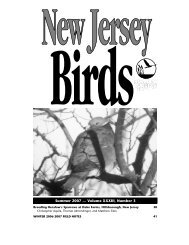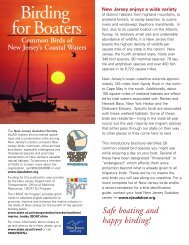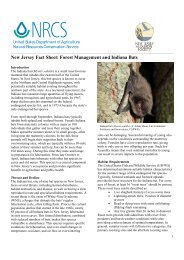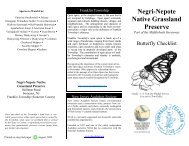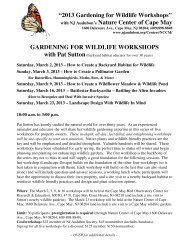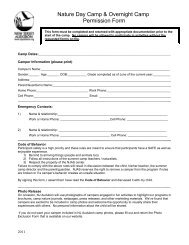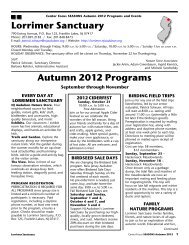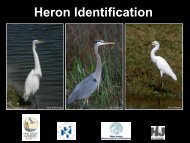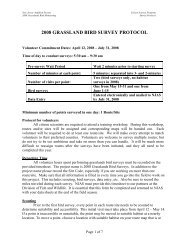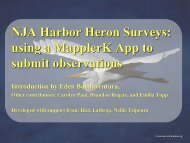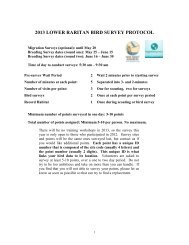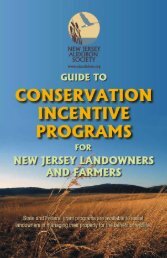March through May, 2009 - New Jersey Audubon Society
March through May, 2009 - New Jersey Audubon Society
March through May, 2009 - New Jersey Audubon Society
Create successful ePaper yourself
Turn your PDF publications into a flip-book with our unique Google optimized e-Paper software.
Brown Booby Sula leucogaster (8)<br />
· <strong>2009</strong>-041. 14 Sep 2008. 10 miles east of Hereford<br />
Inlet, Cape <strong>May</strong> Co. M. Fritz* (ph).<br />
This individual was photographed sitting on top of<br />
a buoy off Hereford Inlet. Care should be used when<br />
identifying young sulids and in NJ should completely<br />
eliminate immature Northern Gannets. Brown Boobies,<br />
unlike other vagrant seabirds, are not normally<br />
associated with hurricanes or tropical storms when<br />
they appear in the state.<br />
Six of the eight accepted records of Brown Booby have come from Cape <strong>May</strong><br />
County, but this is the first one away from shore. It was photographed roosting on<br />
a navigational buoy and also in flight 10 miles off Hereford Inlet on 14 September<br />
2008. Photo/ Mike Fritz<br />
Magnificent Frigatebird Fregata magnificens (4)<br />
· <strong>2009</strong>-042. 8 Sep 2008. Cape <strong>May</strong>, Cape <strong>May</strong> Co.<br />
Female. B. Fogg (ph).<br />
The size and shape of a frigatebird make it easy to<br />
identify, but pinning down which species is involved is<br />
more challenging. This individual was photographed<br />
well enough to show diagnostic characteristics for<br />
Magnificent Frigatebird.<br />
Frigatebird sp. Fregata sp. (20)<br />
· <strong>2009</strong>-043. 27 Oct 2008. Montclair, Essex Co. Immature.<br />
J. Bosler*.<br />
The committee continues to take a conservative<br />
approach and leave some records as “frigatebird<br />
species.” Although many of these birds may well<br />
be Magnificent Frigatebirds, both Great and Lesser<br />
Frigatebirds have been recorded in the U.S.<br />
White Ibis Eudocimus albus (Since 1996) (20)<br />
· <strong>2009</strong>-044. 21 Jul 2008. Cape <strong>May</strong>, Cape <strong>May</strong> Co.<br />
Immature. C. Vogel*.<br />
· <strong>2009</strong>-045. 6 Jul - 24 Aug 2008. Forsythe NWR,<br />
Atlantic Co. Immature. T. Bailey, H. Eskin (ph),<br />
R. Fanning*, S. Treesh.<br />
· <strong>2009</strong>-046. 19 Aug - 13 Sep 2008. DeKorte SP,<br />
Bergen Co. Immature. M.<strong>New</strong>house, R. Duffy<br />
(ph), S. Barnes*, J. Workman*(ph).<br />
Late summer and early fall are probably the best<br />
time to look for this near-annual vagrant to <strong>New</strong> <strong>Jersey</strong>.<br />
Although many records come from coastal Atlantic<br />
and Cape <strong>May</strong> counties, White Ibis have appeared<br />
inland and in the northern half of the state as well.<br />
White-faced Ibis Plegadis chihi (36)<br />
· <strong>2009</strong>-007. 22-26 Apr 2008. Heislerville, Cumberland<br />
Co. B. Boyle*, H.Burk, J. Davis (ph).<br />
Another species on the increase, observers should<br />
still take care to eliminate hybrid Glossy X Whitefaced<br />
Ibis. Careful observation of eye and leg color as<br />
well as the exact color and patterns of the facial skin<br />
are important features to note. Most records in the<br />
state come from the three southernmost counties.<br />
Swallow-tailed Kite Elanoides forficatus (76)<br />
· <strong>2009</strong>-008. 2 <strong>May</strong> 2008. Sandy Hook, Monmouth<br />
Co. J. van Dort (ph), S.Barnes, L. Mack.<br />
· <strong>2009</strong>-008a. 8 <strong>May</strong> 2008. Sandy Hook, Monmouth<br />
Co. J. van Dort (ph), T. Anderson.<br />
· <strong>2009</strong>-047. 11 Sep - 2 Oct 2008. Sussex Co. N.<br />
Powers*, R. McDonnell, G. Smisko*, M. Muller,<br />
J. Kowey, B. Hardiman, L. Obiso.<br />
· <strong>2009</strong>-048. 4 Oct 2008. Cape <strong>May</strong>, Cape <strong>May</strong> Co.<br />
T. Reed, S. Collins (ph), B. Fogg (ph).<br />
An expected “regular rarity” during April and<br />
<strong>May</strong>, the Sandy Hook records fit the species’ typical<br />
pattern of occurrence. More unusual—but definitely<br />
on the increase—are fall records.<br />
Swainson’s Hawk Buteo swainsoni (Since 1996)<br />
(31)<br />
· <strong>2009</strong>-049. 29 Jul 2008. Ocean Co. Adult. M.<br />
McGraw*(ph).<br />
Unprecedented during the summer in the state—<br />
and anywhere in the northeast—this adult bird was<br />
photographed over the Pine Barrens in southern<br />
Ocean County. In the west Swainson’s Hawks begin<br />
post-breeding dispersal during late July and can appear<br />
hundreds of miles away from known nesting areas.<br />
Whimbrel (Eurasian) Numenius phaeopus ssp.<br />
(Since 1996) (4)<br />
· <strong>2009</strong>-010. 21 Apr 2008. Stone Harbor, Cape <strong>May</strong><br />
Co. D. Chaney*.<br />
The Eurasian races of Whimbrel can be reliably<br />
separated from the North American subspecies by<br />
combination of white rump, and paler belly and<br />
underwings. Several nearby states along the eastern<br />
seaboard have multiple records of this subspecies;<br />
most reports come from summer, making this April<br />
record more unusual.<br />
78 — <strong>March</strong> <strong>through</strong> <strong>May</strong>, <strong>2009</strong>



